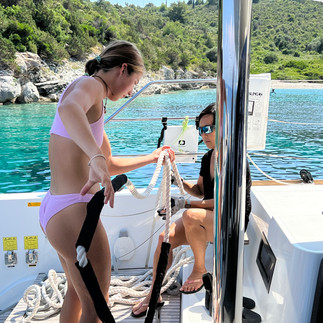It's Greek to me!
- Christine
- Sep 27, 2023
- 3 min read
Updated: Oct 5, 2024
From anchoring to bathrooms, there were many learning experiences unique to sailing the Greek Islands that we adapted to along our journey exploring over 25 islands.
1. Many anchorages are small and space is very tight, so boats are required to attach stern lines to objects on shore to maximize the number of boats in an anchorage and prevent the boat from shifting with the wind or current.
It took some practice, but one must strategically drop anchor prior to backing up towards a rocky shore line. A swimmer (usually Megan) is sent out with a stern line and secures a looped line around a boulder and the process is repeated for a second line to shore. Both stern lines are then cleated to the stern of the boat. The biggest challenge is finding the best, most sturdy boulder while avoiding spiny sea urchins attached to rocks.
Of course, this whole process has to be done in reverse when leaving an anchorage.

Helios anchored Symi anchorage, stern lines attached to boulders on shore
1: Attaching chafe strips to the stern lines. 2-3: Megan letting out a stern line for Dale to secure around a boulder
2. Opportunities to dock at a city berth and be in the middle of town where all the action is!
Being a planner, it was initially very frustrating trying to book a berth in the heart of town, as no one was responding to me. It turns out that no reservations are accepted and getting a berth in town, along a main promenade with shops and cafes is first come, first serve. Somehow, we were always able to find a berth and the city deck hands were always on hand and so helpful with assisting us with our docking lines. These city ports turned out to be great places to dock, as we were in the middle of city life and could watch the world go by from the comfort of our boat or disembark on a whim to shop or grab a coffee. The fees per night were a great deal and we usually had access to electric and water hookups too.
Chania, Crete City Port Symi City Port Kalymnos City Port
3. Needed to be vigilant about dropping an anchor and properly securing lines to a city dock where multiple ferries come in at breakneck speeds, sending waves that can smash your boat against a cement quay.
Video of ferry wake coming into the Heraklion, Crete City Port. Only in this port did we have to engage Helios engines in forward neutral to prevent slamming into the cement quay.

Typical size of ferries in Greece. Note that the catamaran anchored here is not Helios!
4. We had to always be on the lookout for ferry traffic near ports and when anchoring, we strategically chose a spots far enough away from ferry traffic.

In Sikinos, we ended up anchoring pretty close to a ferry dock. In reality, it really was a bit further than it looks in this picture.
5. Sharing prime space with crowded tourist boats.
Any time we found a gorgeous, peaceful anchorage, we would inevitably be surrounded by tourist boats carrying dozens of guests coming and going on an hourly basis. By the evening, it always quieted down. Also, we tried to explore caves and other interesting sites early in the morning prior to "rush hour."

One of the more "tacky-looking" tourist boats.

Typical excursion boats which included a stop for swimming

Turkiye had the same challenges, just smaller excursion boats...
6. Smaller islands have no fuel docks, so we needed to call for a mini fuel truck to pull up close to a dock to fill our tanks. There were water trucks available for those that needed to fill water tanks too.

Mini fuel truck in Poros, where we filled up our dinghy.
7. A transit log and guest log was required to be presented and stamped by the port police and/or harbor master at every island.
This was the most annoying part of our travels since Dale sometimes had a hard time finding the port police or harbor master and it seemed each island had its own rules for filling these documents out and getting them signed. The port police were so kind, but you could tell they didn't like the red-tape system either and were apologetic.

One page out of our transit log
8. Sewage plumbing in Greece is only 2" vs. 4" for the rest of the world, so used toilet paper must be disposed of in a garbage can.
Awkward! Need I say more? But I must mention, the public restrooms (WC's) were absolutely pristine all over Greece.
Dale was so fascinated by these signs, he couldn't help but capture the essence of the message.
.png)

































Comments